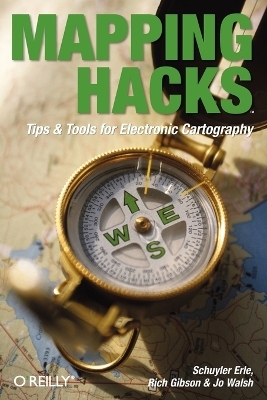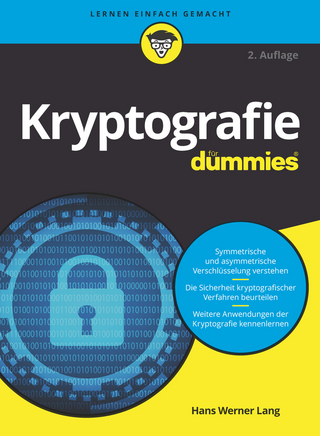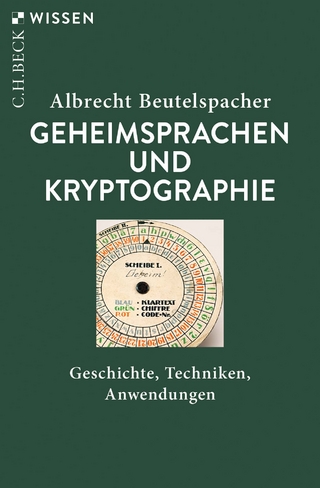
Mapping Hacks
O'Reilly Media (Verlag)
978-0-596-00703-4 (ISBN)
Since the dawn of creation, man has designed maps to help identify the space that we occupy. From Lewis and Clark's pencil-sketched maps of mountain trails to Jacques Cousteau's sophisticated charts of the ocean floor, creating maps of the utmost precision has been a constant pursuit. So why should things change now? Well, they shouldn't. The reality is that map creation, or "cartography," has only improved in its ease-of-use over time. In fact, with the recent explosion of inexpensive computing and the growing availability of public mapping data, map-making today extends all the way to the ordinary PC user. "Mapping Hacks", the latest page-turner from O'Reilly Press, tackles this notion head on. It's a collection of one hundred simple - and mostly free - techniques available to developers and power users who want draw digital maps or otherwise visualize geographic data. Authors Schuyler Erle, Rich Gibson, and Jo Walsh do more than just illuminate the basic concepts of location and cartography, they walk you through the process one step at a time. "Mapping Hacks" shows you where to find the best sources of geographic data, and then how to integrate that data into your own map.
But that's just an appetizer. This comprehensive resource also shows you how to interpret and manipulate unwieldy cartography data, as well as how to incorporate personal photo galleries into your maps. It even provides practical uses for GPS (Global Positioning System) devices - those touch-of-a-button street maps integrated into cars and mobile phones. Just imagine: If Captain Kidd had this technology, we'd all know where to find his buried treasure! With all of these industrial-strength tips and tools, "Mapping Hacks" effectively takes the sting out of the digital map-making and navigational process. Now you can create your own maps for business, pleasure, or entertainment - without ever having to sharpen a single pencil.
Schuyler Erle was born in a small paper bag in Philadelphia, and then again five days later in Baltimore. As a youth, he had to get up every morning two hours before he went to bed in order to walk fifteen miles uphill to school, and then another seventeen miles uphill to get home in the evening. After many years of some nonsense involving Karnaugh maps, a botched attempt at a Red Cross sailing certificate, and the early works of Chomsky, Schuyler was finally and at long last sent packing with something his mentors found at the bottom of a Cracker Jack box. Later, after a tragic accident that left him nearly completely lacking in common sense, he served brief stints on Phobos and Ganymede with the Space Patrol, before returning to study n-dimensional unicycle frisbee golf at a yak herding collective in Miami. Somewhere along the line he made the grave error of attempting to implement a full-scale multi-user web application using a combination of tcsh, awk, and sed, which lead him straight into the arms of O'Reilly & Associates, first as a reader, and then as an author and humble developer. Four years & fifty thousand miles later, we present him in his full and unabridged form, where he hacks Perl behind the scenes at the O'Reilly Network, does on-site technical support for ORA's fine conferences team, is involved in a variety of database and production development projects across the company, and still manages to write and give conference talks for ORA from time to time. Rich Gibson is a Perl/Database programmer in Santa Rosa. He has worked professionally with computers since 1982 when he created Public Utility Rate Case Models in SuperCalc on an Osborne II. While the technology has changed, his fascination with using finger muscle power to control electrical impulses has not. His current fascination is creating tools to aid in the acquistion, management, and presentation of information with a geographic component. He is currently converting an old golf cart into a mobile geo annoation platform. He is active with the NoCat Community Network in Sebastopol, California. In his free time he dives for Abalone and Halibut and tries to keep up with his wife and three explosively active kids.Jo Walsh is a freelance hacker and software artist who started out building web systems for the Guardian, the ICA and state51 in London. She now works with the semantic web, spatial annotation and bots.
Foreword Credits Preface Chapter 1. Mapping Your Life 1. Put a Map on It: Mapping Arbitrary Locations withOnline Services 2. Route Planning Online 3. Map the Places You've Visited 4. Find Your House on an Aerial Photograph 5. The Road Less Traveled by in MapQuest 6. Make Route Maps Easier to Read 7. Will the Kids Barf? 8. Publish Maps of Your Photos on the Web 9. Track the Friendly Skies with Sherlock 10. Georeference Digital Photos 11. How Far? How Fast? Geo-Enabling Your Spreadsheet 12. Create a Distance Grid in Excel 13. Add Maps to Excel Spreadsheets with MapPoint Chapter 2. Mapping Your Neighborhood 14. Make Free Maps of the United States Online 15. Zoom Right In on Your Neighborhood 16. Who Are the Neighbors Voting For? 17. Map Nearby Wi-Fi Hotspots 18. Why You Can't Watch Broadcast TV 19. Analyze Elevation Profiles for Wireless Community Networks 20. Make 3-D Raytraced Terrain Models 21. Map Health Code Violations with RDFMapper Chapter 3. Mapping Your World 22. Digging to China 23. Explore David Rumsey's Historical Maps 24. Explore a 3-D Model of the Entire World 25. Work with Multiple Lat/Long Formats 26. Work with Different Coordinate Systems 27. Calculate the Distance Between Points on the Earth's Surface 28. Experiment with Different Cartographic Projections 29. Plot Arbitrary Points on a World Map 30. Plot a Great Circle on a Flat Map 31. Plot Dymaxion Maps in Perl 32. Hack on Base Maps in Your Favorite Image Editor 33. Georeference an Arbitrary Tourist Map 34. Map Other Planets Chapter 4. Mapping (on) the Web 35. Search Local, Find Global 36. Shorten Online Map URLs 37. Tweak the Look and Feel of Web Maps 38. Add Location to Weblogs and RSS Feeds 39. View Your Photo Thumbnails on a Flash Map 40. Plot Points on a Spinning Globe Applet 41. Plot Points on an Interactive Map Using DHTML 42. Map Your Tracklogs on the Web 43. Map Earthquakes in (Nearly) Real Time 44. Plot Statistics Against Shapes 45. Extract a Spatial Model from Wikipedia 46. Map Global Weather Conditions Chapter 5. Mapping with Gadgets 47. Get Maps on Your Mobile Phone 48. Accessorize Your GPS 49. Get Your Tracklogs in Windows or Linux 50. The Serial Port to USB Conundrum 51. Speak in Geotongues: GPSBabel to the Rescue 52. Show Your Waypoints on Aerial Photos with Terrabrowser 53. Visualize Your Tracks in Three Dimensions 54. Create Your Own Maps for a Garmin GPS 55. Use Your Track Memory as a GPS Base Map 56. Animate Your Tracklogs 57. Connect to Your GPS from Multiple Applications 58. Don't Lose Your Tracklogs! 59. Geocode Your Voice Recordings and Other Media 60. Improve the Accuracy of Your GPS with Differential GPS 61. Build a Map of Local GSM Cells 62. Build a Car Computer 63. Build Your Own Car Navigation System with GpsDrive Chapter 6. Mapping on Your Desktop 64. Mapping Local Areas of Interest with Quantum GIS 65. Extract Data from Maps with Manifold 66. Java-Based Desktop Mapping with Openmap 67. Seamless Data Download from the USGS 68. Convert Geospatial Data Between Different Formats 69. Find Your Way Around GRASS 70. Import Your GPS Waypoints and Tracklogs into GRASS 71. Turn Your Tracklogs into ESRI Shapefiles 72. Add Relief to Your Topographic Maps 73. Make Your Own Contour Maps 74. Plot Wireless Network Viewsheds with GRASS 75. Share Your GRASS Maps with the World 76. Explore the Effects of Global Warming 77. Become a GRASS Ninja Chapter 7. Names and Places 78. What to Do if Your Government Is Hoarding Geographic Data 79. Geocode a U.S. Street Address 80. Automatically Geocode U.S. Addresses 81. Clean Up U.S. Addresses 82. Find Nearby Things Using U.S. ZIP Codes 83. Map Numerical Data the Easy Way 84. Build a Free World Gazetteer 85. Geocode U.S. Locations with the GNIS 86. Track a Package Across the U.S. Chapter 8. Building the Geospatial Web 87. Build a Spatially Indexed Data Store 88. Load Your Waypoints into a Spatial Database 89. Publish Your Geodata to the Web with GeoServer 90. Crawl the Geospatial Web with RedSpider 91. Build Interactive Web-Based Map Applications 92. Map Wardriving (and other!) Data with MapServer Chapter 9. Mapping with Other People 93. Node Runner 94. Geo-Warchalking with 2-D Barcodes 95. Model Interactive Spaces 96. Share Geo-Photos on the Web 97. Set Up an OpenGuide for Your Hometown 98. Give Your Great-Great-Grandfather a GPS 99. Map Your Friend-of-a-Friend Network 100. Map Imaginary Places Index
| Erscheint lt. Verlag | 19.7.2005 |
|---|---|
| Reihe/Serie | Hacks Ser. |
| Verlagsort | Sebastopol |
| Sprache | englisch |
| Maße | 147 x 237 mm |
| Einbandart | kartoniert |
| Themenwelt | Informatik ► Theorie / Studium ► Kryptologie |
| Mathematik / Informatik ► Informatik ► Web / Internet | |
| ISBN-10 | 0-596-00703-5 / 0596007035 |
| ISBN-13 | 978-0-596-00703-4 / 9780596007034 |
| Zustand | Neuware |
| Informationen gemäß Produktsicherheitsverordnung (GPSR) | |
| Haben Sie eine Frage zum Produkt? |
aus dem Bereich


